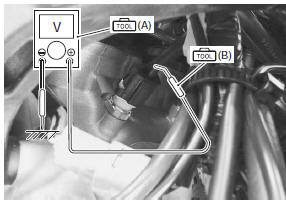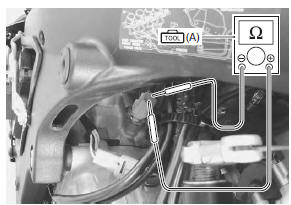Suzuki GSX-R 1000 Service Manual: DTC “c15” (p0115-h/l): ect sensor circuit malfunction
Detected condition and possible cause
|
Detected condition |
Possible cause |
||
| C15 | Output voltage is not with in the following
range.
0.15 V ≤ Sensor voltage < 4.85 V |
|
|
| P0115 | H | Sensor voltage is higher than specified value. | |
| L | Sensor voltage is lower than specified value. | ||
Wiring diagram
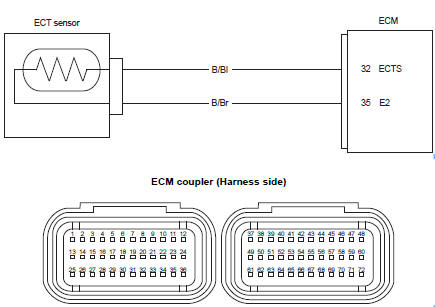
Troubleshooting
| Caution when using the multi-circuit tester, do not strongly touch the terminal of the ecm coupler with a needle pointed tester probe to prevent terminal damage. |
| Note after repairing the trouble, clear the dtc using sds tool. Refer to “use of sds diagnosis reset procedures” . |
C15 (use of mode select switch)
|
Step |
Action |
Yes |
No |
|
1 |
Special tool Tester knob indication
voltage ( Ect sensor input voltage 4.5 – 5.5 V ((+) terminal: b/bl – (–) terminal: ground, (+) terminal: b/bl – (–) terminal: b/br)
Is the voltage ok? |
Go to step 2. |
|
P0115-h (use of sds)
|
Step |
Action |
Yes |
No |
|
1 |
Special tool Tester knob indication
continuity test ( Ecm couplers (harness side)
Is the continuity ok? |
Go to step 2. | B/bl or b/br wire open. |
P0115-l (use of sds)
|
Step |
Action |
Yes |
No |
|
|
1 |
Special tool Tester knob indication
continuity test (
Special tool Tester knob indication
voltage ( Ect sensor output voltage 0.15 – 4.85 V ((+) terminal: b/bl – (–) terminal: ground)
Are the continuity and voltage ok? |
Go to step 2. |
|
|
|
2 |
Special tool Tester knob indication resistance (Ω) Ect sensor resistance approx. 2.45 KΩ at 20 °c (68 °f) (terminal – terminal)
Is the resistance ok? |
|
Replace the ect
sensor with a new one. Refer to “ect sensor removal and installation” in section 1c . |
 DTC “c14” (p0120-h/l): tp sensor circuit
malfunction
DTC “c14” (p0120-h/l): tp sensor circuit
malfunction
Detected condition and possible cause
Detected condition
Possible cause
C14
Output voltage is not within the following
range.
Difference between actual throttle op ...
 DTC “c21” (p0110-h/l): iat sensor circuit
malfunction
DTC “c21” (p0110-h/l): iat sensor circuit
malfunction
Detected condition and possible cause
Detected condition
Possible cause
C21
Output voltage is not with in the following
range.
0.15 V ≤ Sensor voltage < ...
Other materials:
Drive chain related components
Drive chain
Engine sprocket
Rear sprocket
Dust seal
Bearing
Retainer
Sprocket mounting drum
Wheel damper
145 N·m (14.5 Kgf-m,
105.0 Lbf-ft)
60 N·m
(6.0 Kgf-m, 43.0 Lbf-ft)
Apply grease
Apply thread lock to
thread p ...
Transmission removal
Remove the engine assembly from the frame. Refer to “engine assembly
removal” in section 1d .
Remove the engine top side. Refer to “engine top side disassembly” in
section 1d .
Separate the upper and lower crankcases. Refer to “engine bottom side
disassembly” in section 1 ...
Reporting safety defects
If you believe that your vehicle
has a defect which could cause a
crash or could cause injury or
death, you should immediately
inform the national highway traffic
safety administration (nhtsa)
in addition to notifying american
suzuki motor corp.
If nhtsa receives similar complaints,
it ma ...

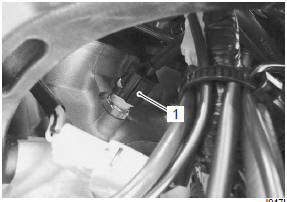
 (a): 09900–25008 (multi
(a): 09900–25008 (multi
 )
)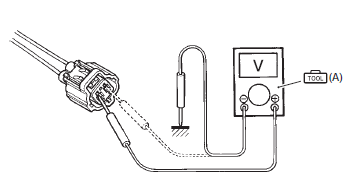
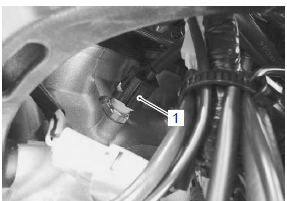
 )
)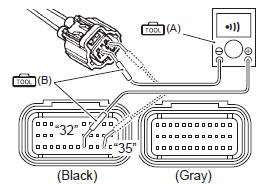
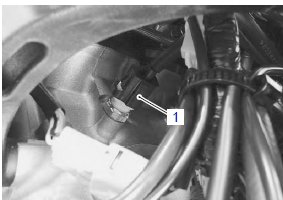
 (a): 09900–25008 (multi
(a): 09900–25008 (multi
 )
)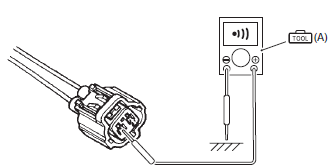
 )
)